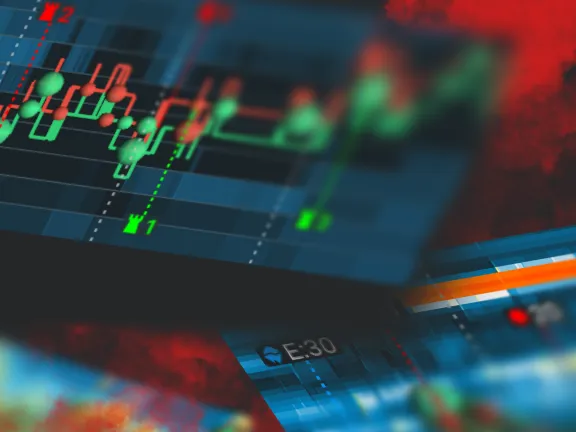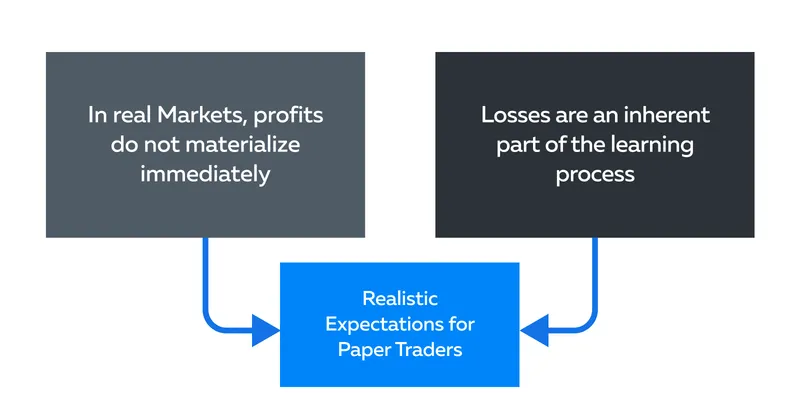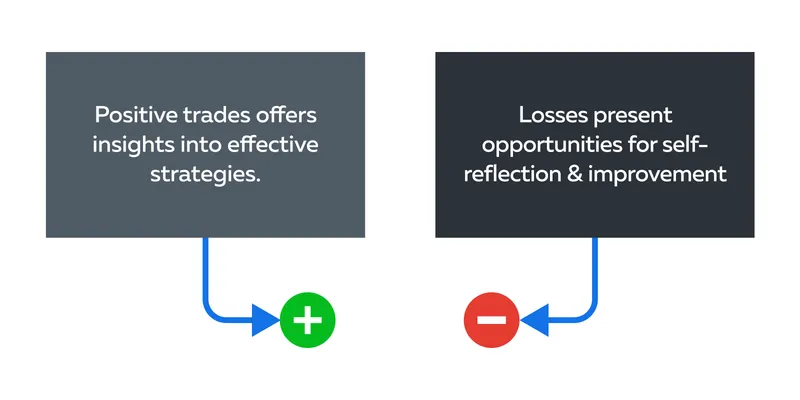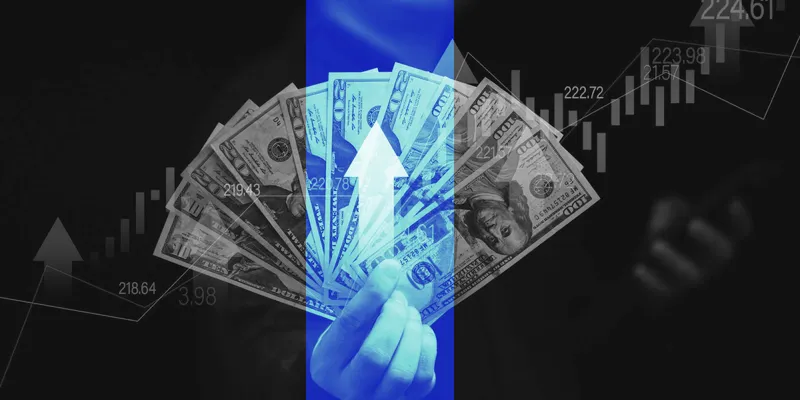

December Trading
Deals Are Live!
Save on Global+, data access,
and add-ons.
See All December Deals

Black Friday
Nov 28-Dec 31
7 days : 6 hours
50% OFF Global+ Quarterly
+ 50% OFF Data (3 months)

Cyber Monday
Dec 1 - Dec 31
7 days : 6 hours
60% OFF Global+ Monthly
+ Data (1 month)

Add-on Deals
Dec 1 - Dec 31
7 days : 6 hours
50% OFF
Add-ons

New Year Sale
Dec 26 - Jan 1
1 days : 6 hours
30% OFF Global+ Lifetime
*Data not included
Education
January 5, 2024
SHARE
From Paper Trading to Real Profits: A Beginner’s Guide to Making the Leap
Success in the stock market is achieved through exposure to various market
situations and a steadfast commitment to continuous practice. But you cannot
burn money just for the sake of getting better. This is where paper trading
comes to your rescue. It is a valuable technique that allows you to practice
and refine your strategies without financial stakes.
Through this article, you will explore the differences between simulated and
actual market experiences, the strategies for managing risks, and how to
take those crucial first steps into live trading. Also, we will be exploring
the common psychological shifts and help you in developing a thoughtful
transition plan.
As you read further, we will guide you on how to utilize tools like Bookmap
for market analysis. Let’s get started.
What are the Differences Between Paper and Real Trading?

Paper trading is a simulated environment for practice without any financial
consequences. Conversely, real trading involves actual financial
transactions with the goal of making profits in live markets.
The transition from paper to real trading encompasses various challenges,
including:
-
Psychological shifts
-
Financial considerations, and
-
The need for adaptive strategies
Let’s explore them in detail.
The Psychological Shift
When performing paper trading, participants engage in simulated market
scenarios. They do not experience any tangible financial consequence.
Since emotional stakes are significantly lower, this detachment often leads
to a skewed perception of risk and reward. Conversely, when real money is on
the line, traders often get influenced by emotional triggers and experience
both the fear of loss and the allure of potential gains.
How Do Emotional Differences Come into Play?
-
The transition from paper to real trading triggers a surge in
emotions. -
Fear, greed, and anxiety intensify when actual capital is at risk.
-
Traders find themselves grappling with doubts and second-guessing
strategies that were executed with ease in a simulated environment.
Understanding these emotional differences is crucial for developing
resilience and adaptability.
How to Manage Psychological Pressure
To effectively manage the associated psychological pressures, traders must
adopt effective stress management techniques, such as:
-
Mindfulness meditation
-
Deep breathing exercises, and
-
Maintaining a well-defined trading plan
These techniques can mitigate the impact of heightened emotions. Also,
traders who practice them regularly can easily acknowledge that losses are
an inherent part of the trading journey.
Financial and Risk Considerations
When transitioning from paper to real trading, one of the most significant
shifts lies in the management of capital. In paper trading, participants
often have an unlimited virtual budget which is not the case in live
trading.
Real traders must meticulously budget and allocate their capital after
considering their:
-
Risk tolerance and
-
Financial goals
Additionally, they must ensure that each trade aligns with a well-defined
risk management strategy.
How to Deal with Losses and Risk Management
Losses in paper trading lack the emotional impact associated with real
financial setbacks. Thus, real traders need to develop robust risk
management techniques by incorporating the following tools:
-
Stop-loss orders
-
Position sizing, and
-
Diversification
Note: Traders must understand the implications of leverage in real trading
scenarios and execute their trading plans with due diligence.
Market Dynamics and Execution
Market dynamics in real trading are more complex than their paper
counterparts. Concepts such as slippage, liquidity, and market depth play
pivotal roles in shaping outcomes. Traders must adapt their strategies to
account for them. Let’s understand how paper traders can adapt to real
market conditions.
How to Adapt to Real Market Conditions?
Paper traders must understand how various factors influence price movements.
They should be prepared to modify their strategies based on factors like:
-
Market volatility and
-
Liquidity
To gain a competitive advantage, traders can resort to tools like Bookmap,
which provide visual representations of market depth and order flow.
Utilizing such tools enhances a trader’s ability to make informed decisions
in response to real-time market dynamics.
How to Prepare for the Leap to Real Trading
Leaping from a simulated trading environment or paper trading to real
financial markets requires careful preparation. Let’s explore how aspiring
paper traders can leap to real trading by creating a well-structured
transition plan and a robust risk management framework.
How to Develop a Transition Plan
The first step in preparing for real trading is to establish clear,
achievable goals and a realistic timeline. These goals include:
-
Financial targets
-
Skill development milestones, and
-
Specific trading achievements.
Setting a timeline creates a sense of structure and allows traders to
measure progress along the way.
The second step is to create a comprehensive risk management framework. This
includes:
-
Defining risk tolerance
-
Determining position sizes, and
-
Incorporating tools like stop-loss orders
Traders must meticulously plan how much of their capital is at risk in each
trade and establish protocols for handling losing streaks. This framework
acts as a safeguard against emotional decision-making and provides a
structured approach to real-time trading.
Setting Realistic Expectations
The paper traders must understand that real markets differ significantly
from simulated environments. This makes setting realistic financial and
trading expectations pivotal.

What is the Importance of Keeping Realistic Financial Expectations?
Unrealistic financial expectations can lead to frustration and impulsive
decision-making. Traders should recognize that consistent profitability
takes time to achieve. They must appreciate the importance of gradual growth
and invest in a long-term horizon.
How Does Maintaining a Long-Term Perspective Help?
Success in trading is often a marathon rather than a sprint. Traders who
adopt a long-term perspective foster patience and persistence. They must:
-
Learn from your past experiences
-
Adapt to strategies, and
-
Continuously improve
Building Confidence and Skills
To effectively transition, traders must continuously develop their skills
and build confidence. For this purpose, they can follow the following steps:
|
How to Develop Skills? |
How to Build Confidence? |
|
Hone your technical analysis skills |
Begin trading with modest trade sizes |
|
Stay informed about market trends |
Increase your trade size gradually with growth in |
|
Regularly update knowledge about the financial |
Review your successful trades and learn from your |
|
Understand macroeconomic factors |
Don’t execute large trades to minimize the emotional |
Taking the First Steps in Real Trading
Stepping into real-world trading, traders must start with small and
manageable steps. They must keep managing risk and leveraging early
experiences for continuous learning and improvement. Let’s delve deeper.
Starting Small and Learning
Beginning with Smaller, Less Risky Trades
-
The first foray into real trading should involve starting small and
gradually scaling up. -
Thus, traders must initiate trades with smaller positions.
-
This cautious approach serves as a practical introduction to the
emotions and decision-making processes applicable in real trading.
Progressively Take on More Substantial Positions
-
As traders gain confidence and experience positive outcomes, they
can consider taking on more substantial positions. -
However, the progression should be gradual and must align with the
trader’s:-
Growing proficiency and
-
Comfort level
-
-
This incremental approach mitigates the risk of large losses during
the initial stages of real trading.
How Does Learning from Early Trading Experiences Help?
Every trade, whether successful or unsuccessful, provides invaluable
lessons. By dissecting both successful and unsuccessful trades, traders can:
-
Refine their approaches
-
Adjust strategies, and
-
Enhance their overall trading skill set
This is how positive trades and losses guide traders:

Adapting and Refining Strategies
Real trading is a dynamic and ever-changing landscape. To be successful,
traders must:
-
Adapt and refine their strategies continuously
-
Learn from each trade
-
Understand market dynamics, and
-
Identify patterns of success and failure
Most importantly, traders can use advanced market analysis tools like
Bookmap for real-time analysis. These tools offer a visual representation of
market depth and order flow that help traders gain deeper insights into
market liquidity and fine-tune their strategies for better performance in
live trading environments.
Ongoing Risk and Capital Management
Effective risk management is an ongoing process in real trading. The traders
should:
-
Practice Diversification
-
Spread their trades across different assets and markets
-
This helps in mitigating the impact of adverse movements in any
single position.
-
-
Regularly Review and Adjust:
-
Develop effective risk management strategies and keep aligning
them with the trader’s:-
Risk tolerance and
-
Overall market conditions.
-
-
How to Grow Trading Capital Responsibly
Growing trading capital requires a balanced and responsible approach. The
traders can follow these steps:
-
Reinvesting profits back into trading activities
-
Avoiding over-trading, as excessive or impulsive trades can erode
capital -
Focusing on maintaining a disciplined approach to position sizing
-
Recognizing the importance of patience and prudent decision-making
Conclusion
While transitioning into real trading, the traders recognize the immense
potential for personal and financial growth. However, it is crucial to
acknowledge the challenges that lie ahead.
As a new real trader, you must embrace the learning process and view each
trade—whether a triumph or a setback—as a stepping stone towards mastery.
Understand that success in trading is a journey, not a destination. It
requires resilience, continuous learning, and an unwavering commitment to
adapting and improving.
Moreover, to get ahead in trading, traders can use tools like Bookmap for
market analysis that help visualize how much trading activity is happening
at different prices. This visualization makes it easier to understand market
trends. Are you ready to take your trading from simulation to reality?
Dive into our comprehensive guide, ‘Trade Via Bookmap: A Detailed
Step-by-Step Guide’, to understand how you can apply your trading skills in
the real market using Bookmap. This guide will provide you with the
practical steps to begin your real trading journey confidently.
Start Your Real Trading Journey with Bookmap.
